Are you dreaming of landing freelance clients remotely and get the control to quit your job?
The first step is writing a cover letter on Upwork that wins a client over to your side. In this guide, you and I will dive deeper into what good and bad proposals look like and the specific steps to master writing them.
You’ll need to know less than you think and practice more but don’t worry, we’ll cover everything you need. This is the best skill you can master to earn money on the side. I know that’s a bold statement and think about it: even if you could do nothing else, you can offer to help businesses write proposals or sell their services for them.
I take a different approach than most others because I don’t feel good about coming across as salesy. To my luck, it turns out to work really well as you might have seen in the case studies here.
The trade-off is that it requires more work than the average freelancer puts in, so truth be told, this is not for everyone. If you feel lazy and freelancing isn’t that important to you, no judgment from me but this probably isn’t what you are looking for.
With that note out of the way, let’s dig in!
Update: I prepared an article on writing strong Upwork proposals over at Millo in case you are serious about landing clients.
No matter if we are looking for a freelance gig, a traditional job, running a marketing campaign, writing copy or anything else that has an element of persuasion to it, we tend to win by first understanding what the client is looking for before crafting what we’ll show them.
To make this guide on writing a winning cover letter on Upwork very real, let’s first upload a project to the website and see what happens before we dive into the nitty-gritty of how to master the Upwork proposals.
How freelance clients experience Upwork
We could have picked any type of project, so to make this easy to follow for many of us, let’s pick a project around lead generation research.
First, we need to decide on a job title and category.

Next, we click update and move on to writing what we think is a good and descriptive project description. I took the liberty of preparing one that you can see below – I apologize for the zoom out, I wanted to add everything there for you to see.
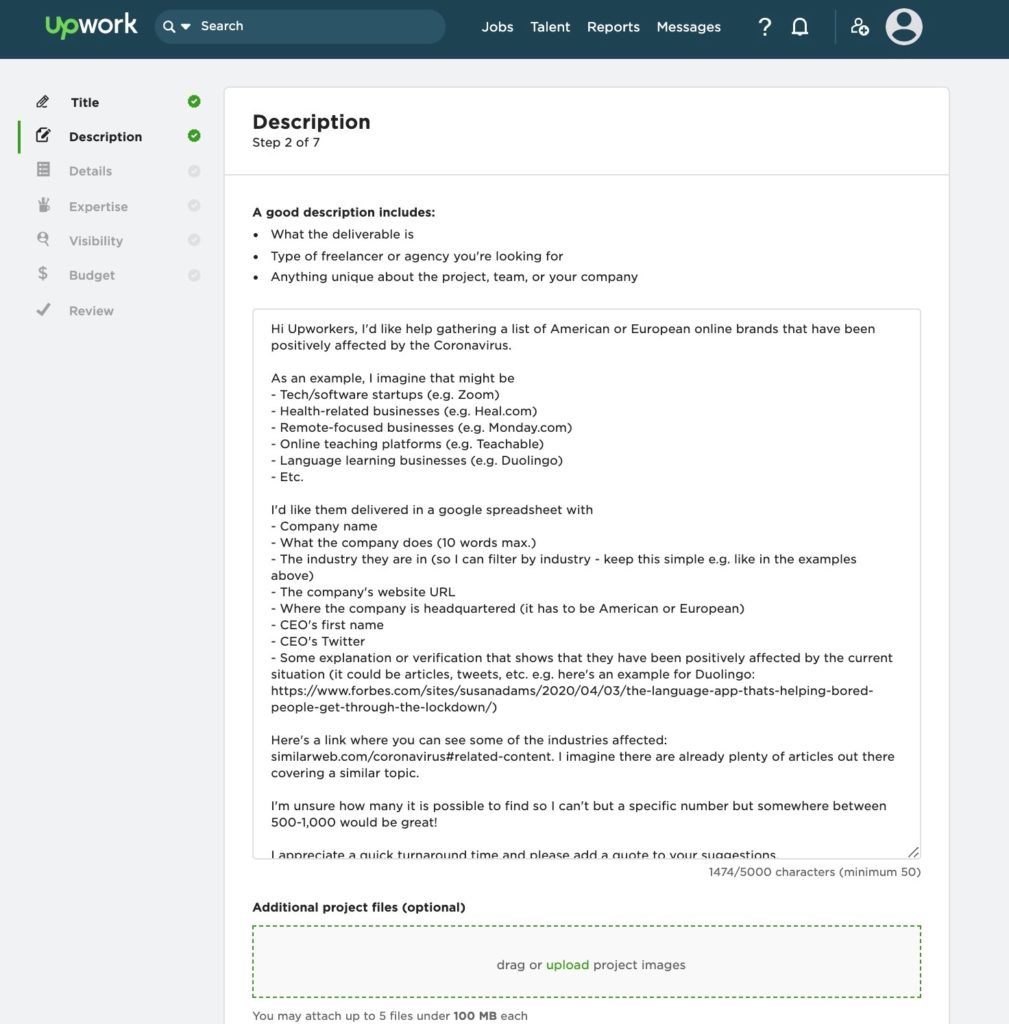
Let’s make this a one-time project and move on.

There are so many different skills we can attach to the project. It feels as if there are too many to choose from, so let’s just pick quantitative research and move on.

On the same page we also have to pick some skills. It is unclear what this is for, so let’s stick with market research and data entry.
We also need to share what level of experience the freelancer should have. It’s difficult to judge, so let’s pick the one in the middle. It’s probably a nice balance.
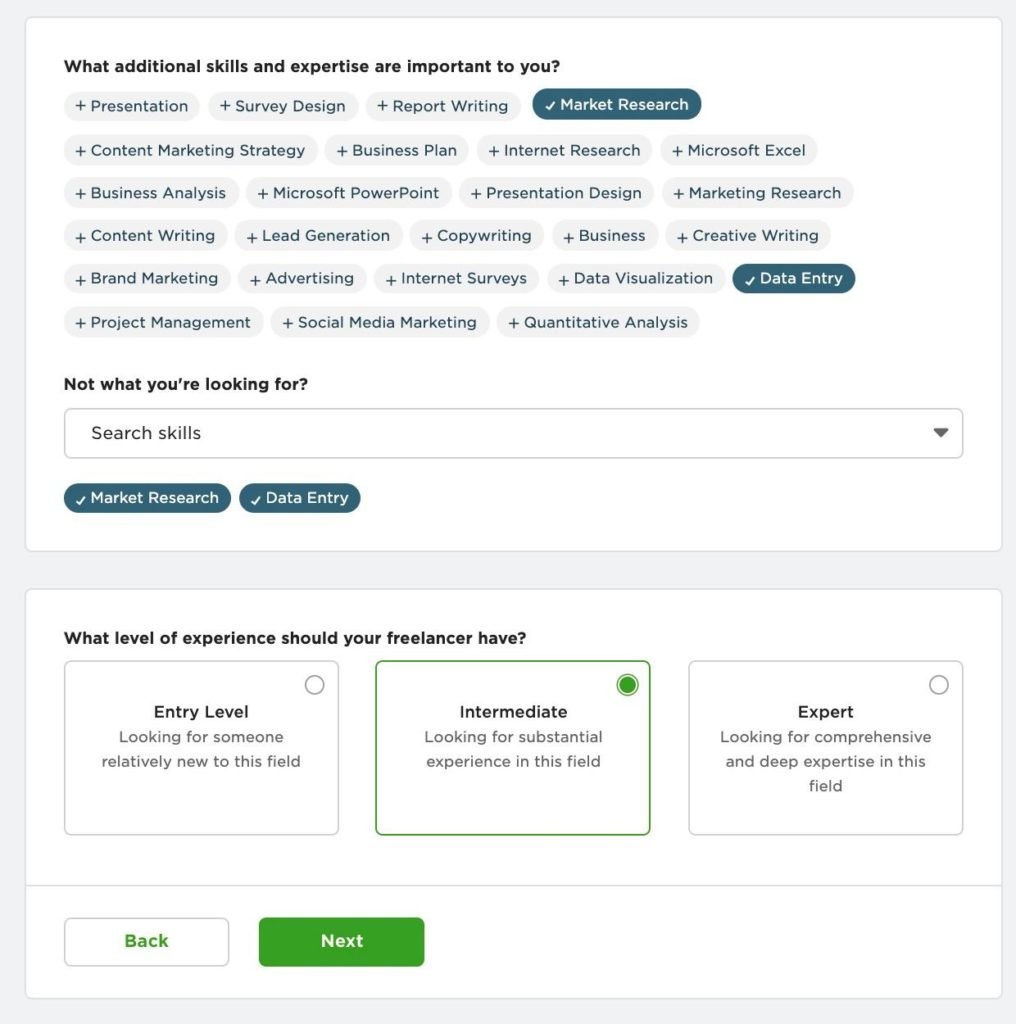
Next, we have to select if we only want to invite a specific freelancer or make it public, and how many freelancers we need. One freelancer will do for this project. Let’s keep it open and get some bids so the freelancers can show us what they got, shall we?

Finally, it seems, we have to enter the budget. A fixed price seems like a good bet but I don’t know how much this is worth. Especially, since we don’t yet know how many leads are out there and we want to pay what’s fair without getting ripped off.
Let’s say $1 per lead and add $200. Perhaps we are able to change it later.
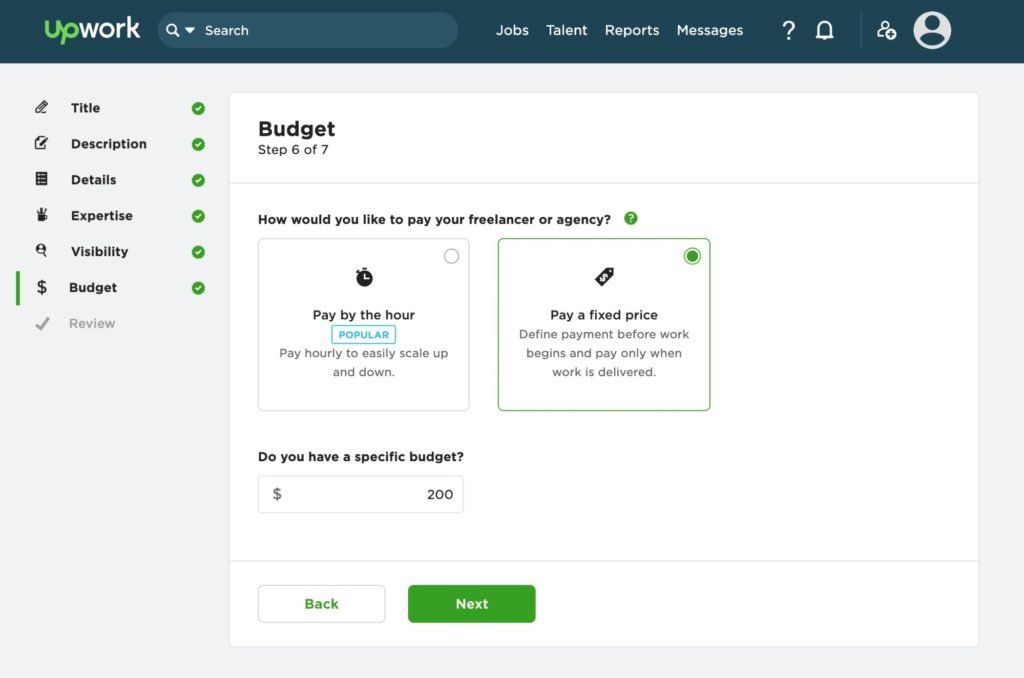
A quick review of our details and we are off to the races.
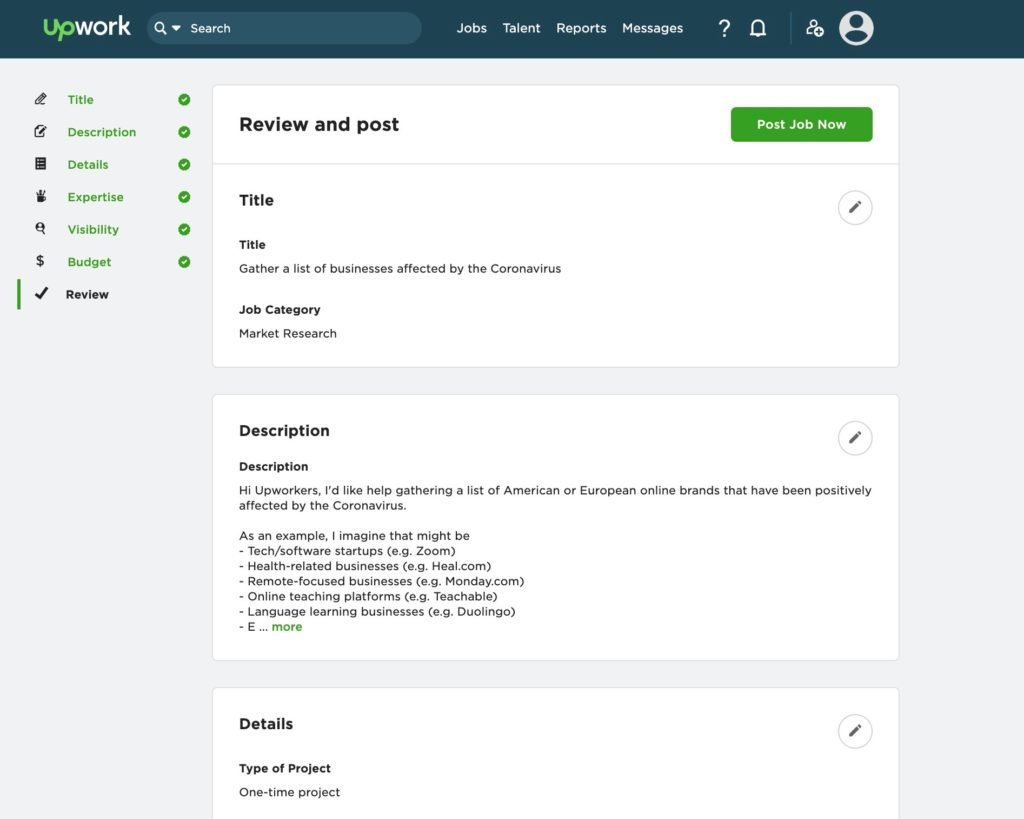


Yay! Our project is live! We are taken to this page and suggested to invite freelancers but since we don’t know any, we’ll let the freelancers come to us with proposals.
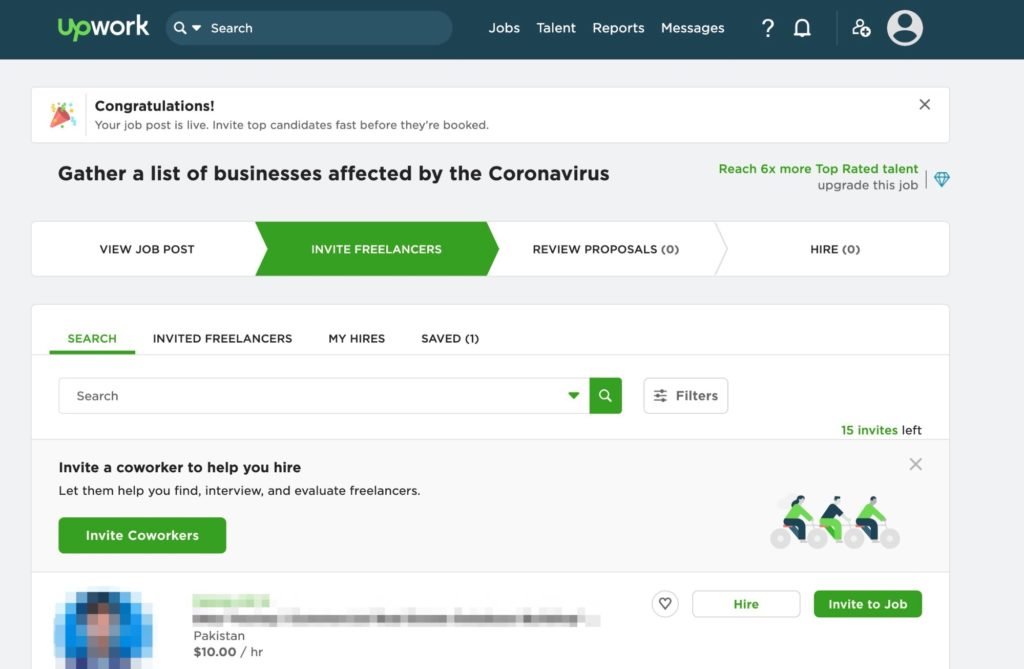
Fast forward two days… Let’s see if we got any proposals.
..We did! We got 20 proposals. This is what it looks like when we browse through the proposals:
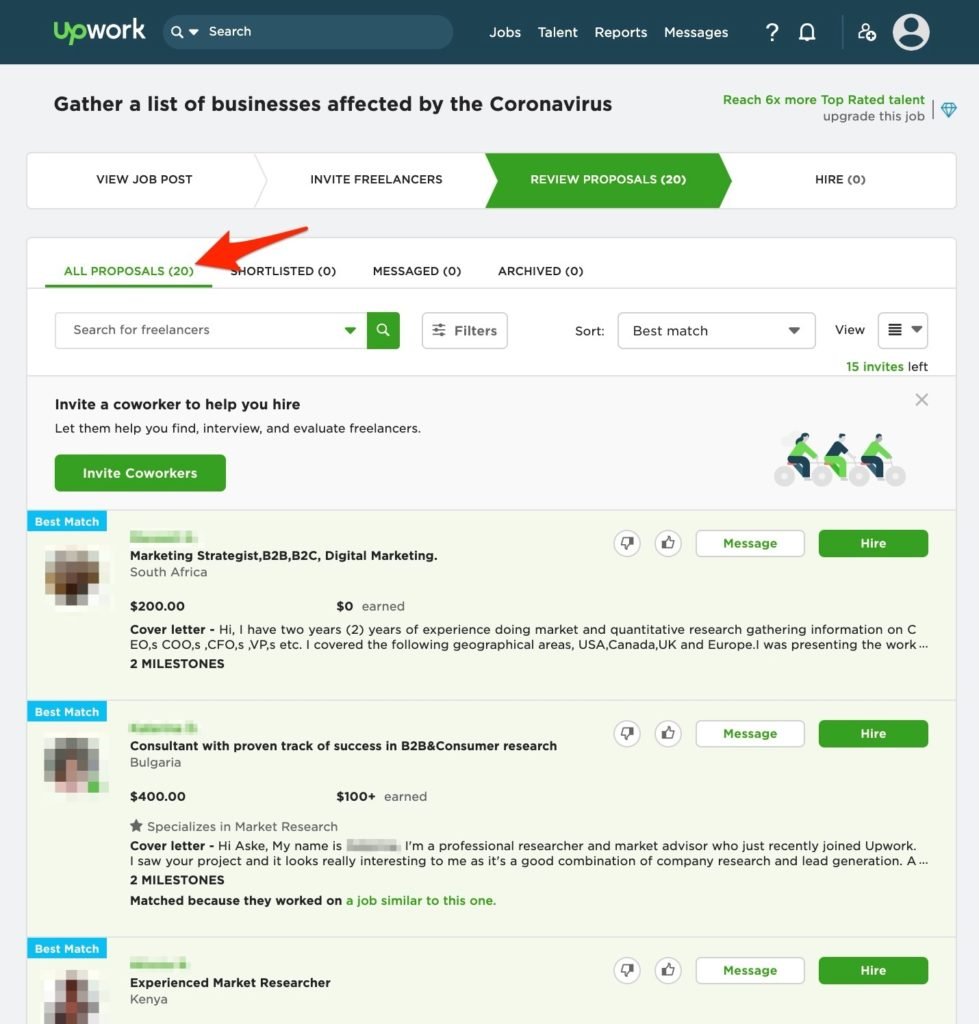
Somehow Upwork has decided for us that 14 out of the 20 options are the “best match”. Let’s take a look. I have blurred out any personal details out of respect for each freelancers’ privacy.

Let’s look at the other proposals…

Wow, this is a long proposal. Interesting. The freelancer found and included my name which is great.
This next proposal is long, so I had to bite it up into two screenshots.
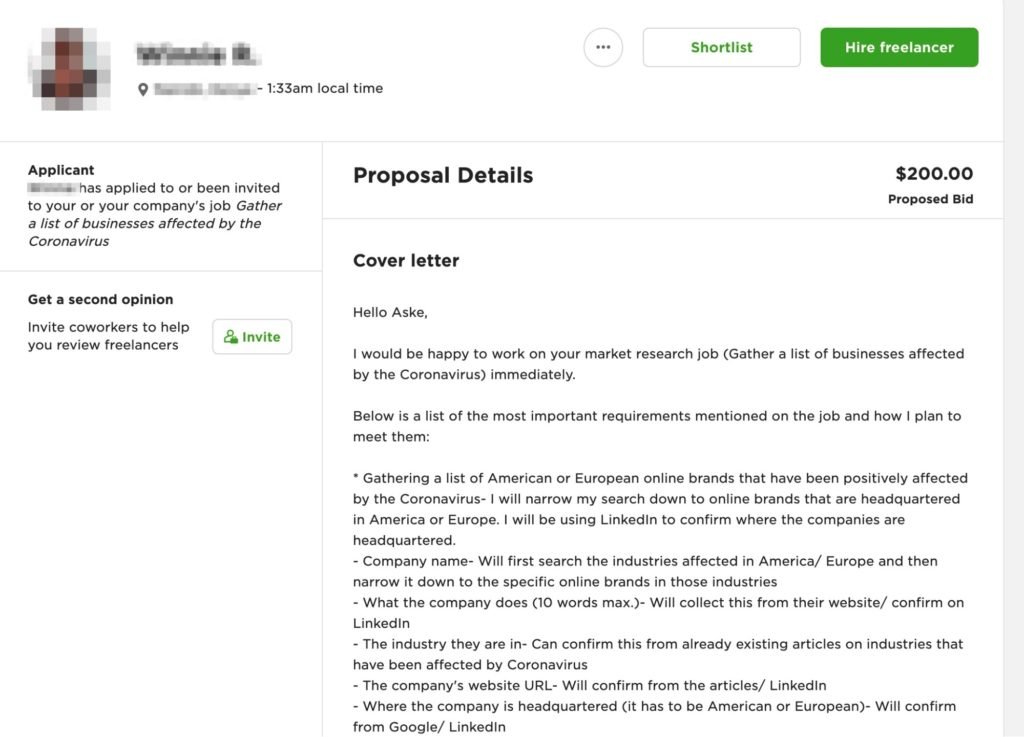

Besides the fact that this is very long and a good chunk of it feels like rewording of the project description, this isn’t bad either. The freelancer has a few questions and has thought about the project along with specifics that we will receive as a client. Not bad at all.

This next one has attached an example from a similar project. For privacy of the people in the doc, I’ll not add it here but the formatting looks like what you and I are looking for.
The proposal is nice, short and not bad at all. Let’s see what else we have.
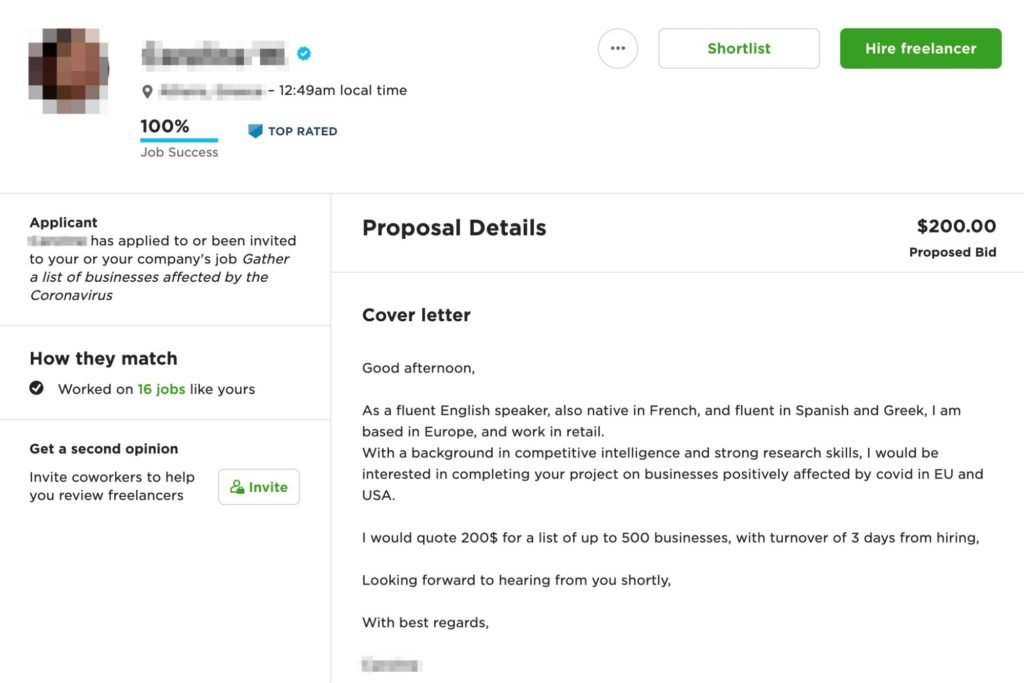
I’m not entirely sure how the language skills help with the project. Are you? Anyway, let’s not sit and think about how it might, with all the cover letters we have to go through.
We are busy and this is just one task out of many that we have to do as a client running a business. It’s one of those cases where it would be great if the freelancer had explained how it could help the project.
The rest of the proposals are quite similar… except for these two:
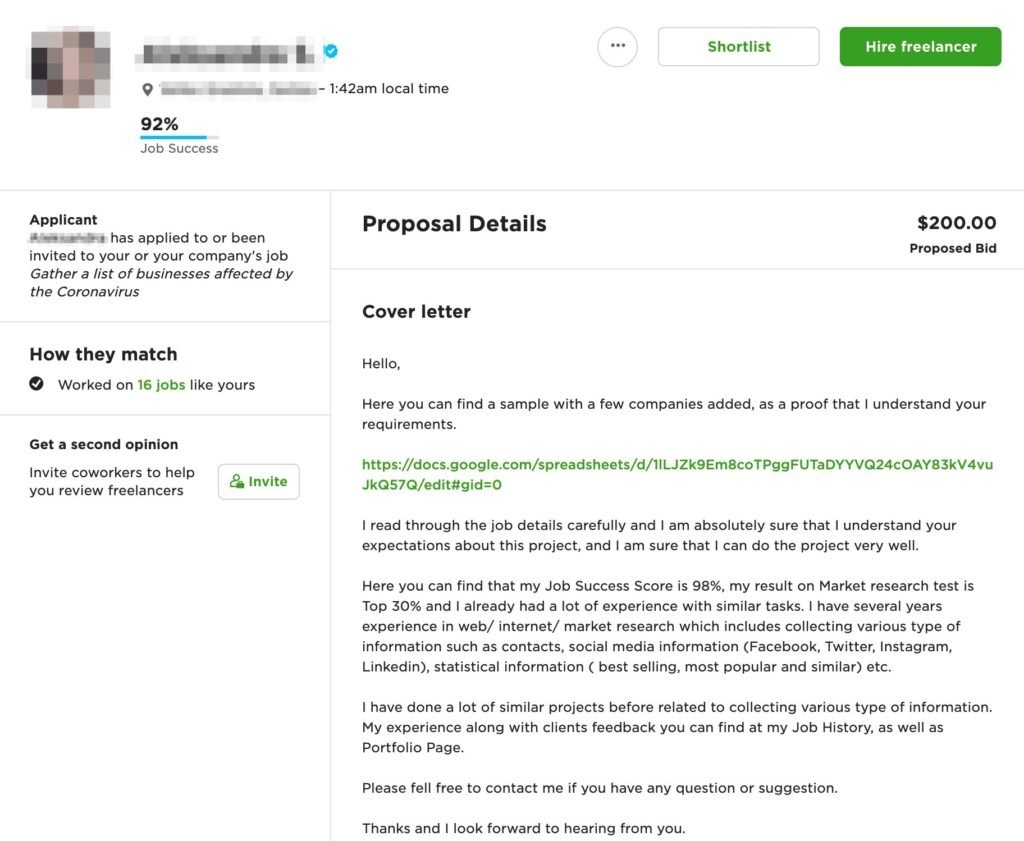
Nice! Look at this doc:

The freelancer showed a sample of what our project would look like. There were only one other candidate that did the same thing:

The proposal itself doesn’t feel that relevant to the project but based on the sample below it feels as if the freelancer understands what we are looking for. Right?

There are plenty more, similar, proposals. Since you are busy and don’t have all day to look at this (just like clients don’t), let’s leave it with those highlights.
Looking over these proposals, what do you notice?
I notice a few things:
We got a few different “categories” of proposals:
- The “hail mary” copy-paste proposal that isn’t really relevant
- The ones that tried to explain how their experience was relevant
- The ones that showed us what the project would look like when it is completed
As a client it feels easier to judge if someone is the right fit by showing us something rather than telling us about their background.
Particularly, because it is hard to trust that we are on the same page — even if someone says they understand, I’ve worked in outsourcing and remote projects for long enough to know that just saying someone understands is no guarantee that the two parties are on the same page.
Communicating between client and freelancer, and being on the same page is the biggest challenge with outsourcing, so it is extra important that even if we feel we understand, that we also work to make the client feel that we understand because there is a high chance we are not on the same page.
Especially, clients experienced at hiring will be concerned about this and we’ll look experienced and score some easy points by pointing out that we know this is a problem and work to mitigate it. Telling something is easy – I can tell you that I know how to build a new Facebook but why would you believe me? Saying stuff is easy.. Especially on the internet.
It is really challenging to make the solution attractive based on explaining ourselves compared to showing the sample as a few of the freelancers did. There is something to the visual aspect.
At this point in the hiring process, we haven’t even looked at pricing, the Job Success Score, testimonials, top rated-badges or anything like that.
It didn’t even cross my mind since we first need to make sure that we are getting what we are looking for and we got that proven from two people.
Almost all of the proposals were focused on the freelancer writing it rather than the project and the client. The irony is that I wouldn’t have thought about their background much if they haven’t focused so much on highlighting it.
And guess what: just as the freelancer is thinking about themselves, we as the client is doing the same. Everyone is and it’s normal. I don’t really care about their background, just whether they can do the project well or not.
Since most of the freelancer competition thinks about themselves, if we do the opposite, we’ll stand out immediately.
Another thing that I noticed in the proposals is that I didn’t feel any personal connection. I know this isn’t obvious but I would have loved to see a more personal or friendly way of writing the proposals. Most of the proposals felt very formal and in some cases even formulaic.
Even though freelancers are able to see how many proposals have been submitted, no one seemed to comment or mitigate the fact that there were a lot of competing freelancers for the same project.
Many of the proposals would have been decent or perhaps even gotten a shot if there weren’t any other proposals… but there were.
Since we can only hire one freelancer for the project, it’s a winner takes all scenario so if someone would make it 10% better, they would probably win.
With a lot of proposals and little time (being a busy client), it can feel overwhelming to look through many proposals and none of the freelancers seemed to consider that — and even if they did, we don’t know what they are thinking if they don’t share it with us. It doesn’t feel fair as a freelancer, I agree, but it is the world we live in and I’ve seen clients feel this way so many times.
I’m pleasantly surprised that there are more customized proposals whereas in the past, I’ve seen that most of the proposals have been lazy and irrelevant copy-paste cover letters.
Experienced clients see right through the template proposals, especially since there are many other proposals to compare with.
If we take the time to write even a basic custom proposal, we move from the worst bracket and into the middle bracket (in the three proposal brackets we talked about earlier) that might be considered for the project depending on the competition.
The challenge is that in most cases there can be only one winning freelancer, so we need to be the best. Luckily, it often isn’t that challenging.
Now, with a basic perspective of how it feels to be on the client side, let’s look at what good proposals look like and how we can create our own.
But first, let’s look at why we keep sending the same proposals even if they don’t land us any jobs and how clients are pitched by other freelancers outside of Upwork compared to on the website so we have a basic reference point.
[convertkit form=2588400]Why we keep sending proposals that don’t land jobs
We’ve all tried doing something that doesn’t work like sending out proposals that doesn’t land clients. After sending out a bunch of similar ones and not hearing back, why do we keep applying in the same way even though we know it probably won’t work?
Or in other words, why do we keep doing the same thing yet expect a different result?
This quote is often signed as said by Einstein but that doesn’t seem to be true: “The definition of insanity is doing the same thing over and over again and expecting a different result.”
Either way, the point is great.
For some of us it is because we feel like we are working even though we know that working and making progress is not the same thing.
We are used to focusing on the number of hours we work from our traditional job but here on Upwork/with freelancing, we win by focusing on impact.
To mitigate it, we can for example create a habit around having a “doctor’s appointment” where we go undisturbed to dive deeper into the project for a little bit.
This requires reframing since we are used to clock in and out of jobs for a long time, and so this will naturally take a while to change.
This is one of the most powerful life lessons I’ve learned from freelancing and ironically, working in a traditional job, modern bosses tend to love this since it moves their business forward. Clocking in and out is just a metric created to hopefully help drive an impact on the bottom line but it isn’t a very good fit for that.
Examples of winning cover letters on Upwork
An Upwork proposal is different from what clients normally consider a proposal. On Upwork, this is the first impression the client gets of us whereas outside of Upwork, the proposal is usually the final recap of a potential project.
This graphic can serve as a summary:
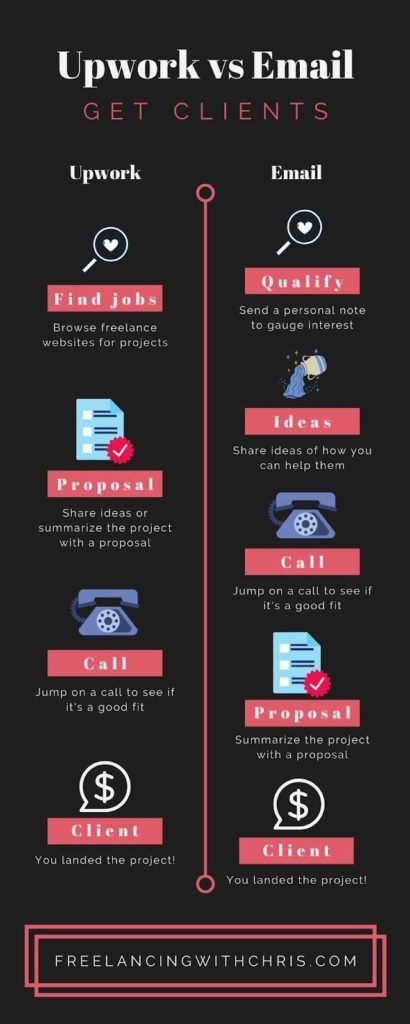
As you’ll see, we’ll normally have had the opportunity to establish that we are good at what we do, discuss a specific project, and perhaps even flesh out the details. On Upwork, it is the other way around.

An Upwork proposal consists of a cover letter and sometimes additional questions, although the word “cover letter” is sometimes used interchangeably with “proposal”.
So what does a good Upwork proposal look like? Let’s dig in by first look at a few example proposals that won the project they were pitching for!
Upwork cover letter examples
The job description

The Upwork cover letter

The project was won at $35/h.
Another example. The project description:

The Upwork cover letter

Won at $250.
Another example. The project description:

The cover letter:
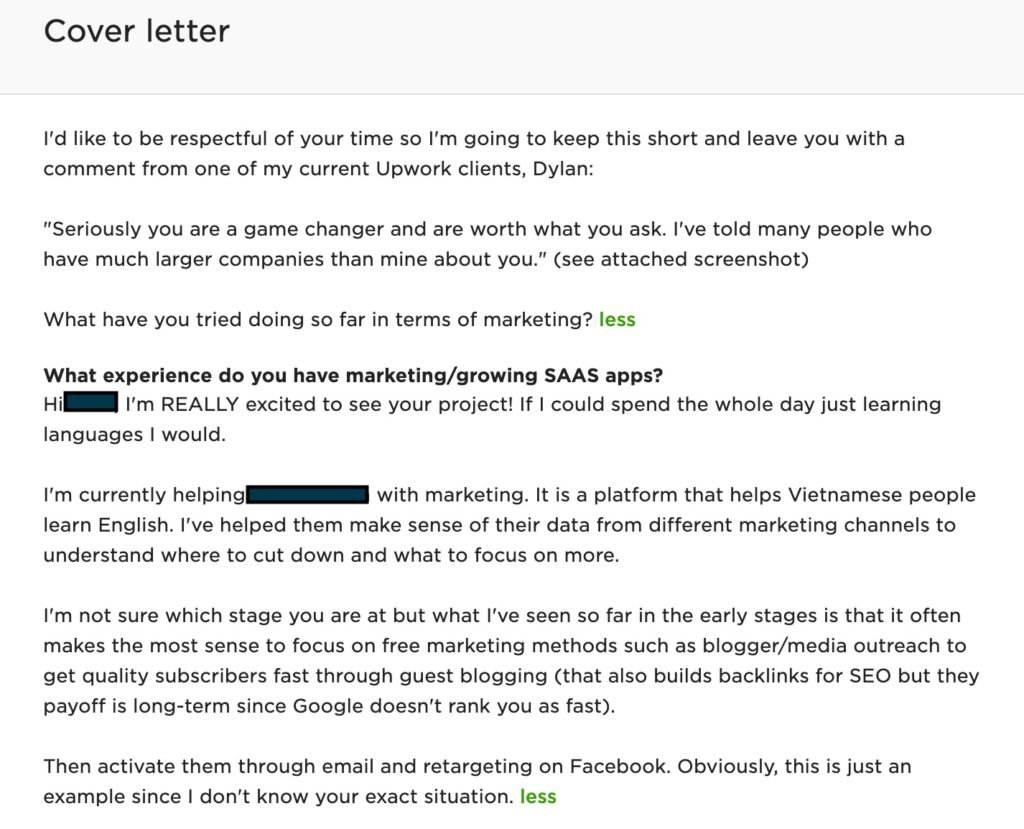


Earnings:

Another example. The project description:

The Upwork cover letter:

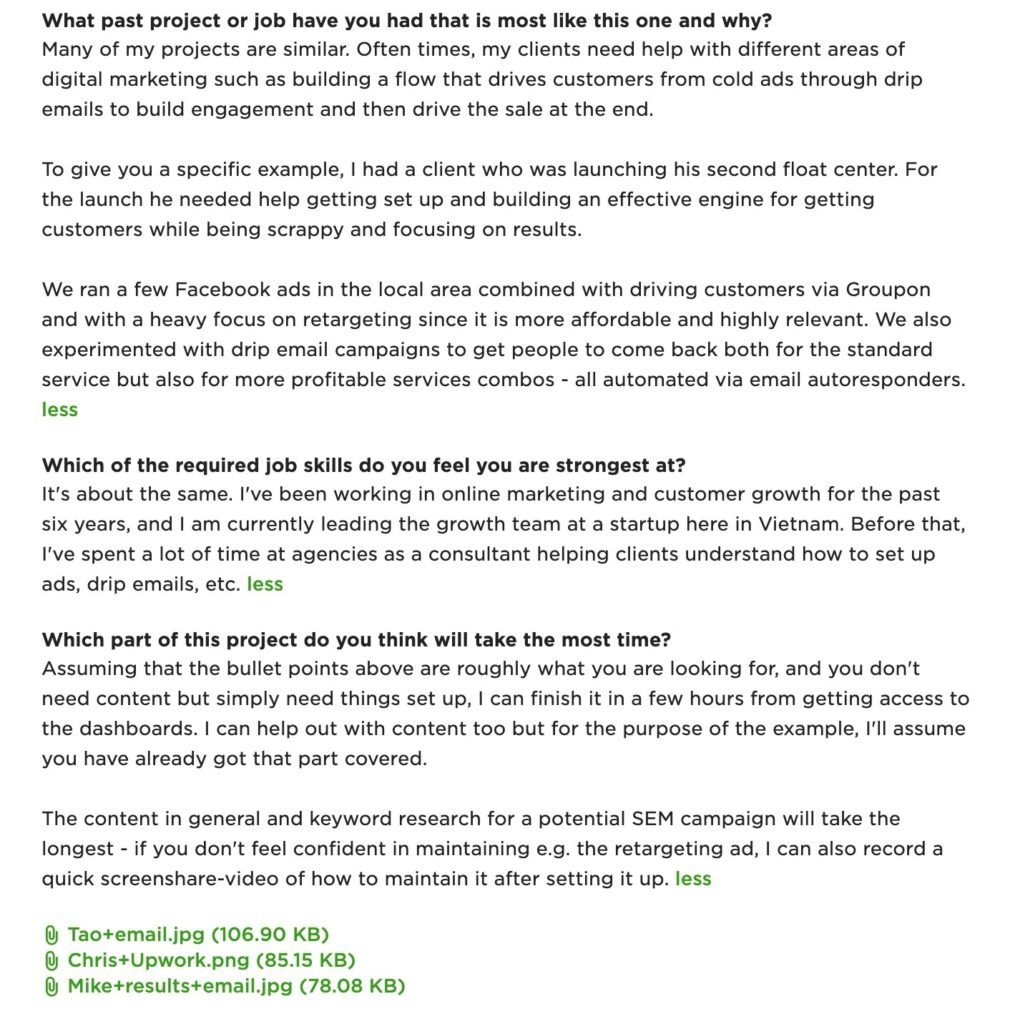
Earnings:

Why did these Upwork cover letters work?
Let’s see which insights we can extract from the cover letters. What do you notice?
I notice that the proposals feel custom written to each of the projects — they show that the freelancer took the time to get to know the client and project before applying. There are some minor mistakes here and there. They are not perfect and that’s OK too.
The cover letters are SPECIFIC both in terms of addressing the project but also the freelancers’ background. They comment specifically on the project or business showing that they did their research.
I also notice that they often point out a specific unknown in the project that the client might not have thought about. Something that is needed in order to give accurate advice or price.
They take one of the following approaches (or both): friendly with genuine interest or focus on being the expert.
They are not trying to be the expert by writing a long essay about their experience, in fact, they tend to have only a small section about the freelancers’ expertise or background.
And finally, they end with a CTA to make the conversation and next steps easier for the client.
Other insights I’ve noticed are:
- The human aspect is more important than we think. I’ve earned a lot by being friendly, thoughtful of the client’s time, and focused on what they wanted – not always what I thought was best
- Showcasing our expertise and portfolio is important. Just not as always much as we like to think.
Next, let’s dive into how to apply these insights in our own Upwork cover letters.
[convertkit form=2588400]Step by step guide to writing Upwork cover letters that win projects
A quick note before we begin. Since I’ve covered most of the frequent Upwork cover letter questions more in detail separately, I will not be diving into them here but I here are the links to each of them in case you need to dive in:
- Why do you think you are a good fit for this particular project?
- Do you have suggestions to make this project run successfully?
- What part of this project most appeals to you?
Let’s put everything we’ve learned together into the three key sections in the proposal:
- The hook
- The meat
- The close
Step 1: The hook
Direct response copywriting is the art of writing copy that persuades people to do certain things — usually buy a product.
That rule is that the headline only has one purpose: to get the reader to write the first paragraph. And the first paragraph only has one purpose: to get the reader to read the second paragraph.
You get the gist. When we apply for Upwork jobs with many proposals that are already submitted, this is particularly important, since it is easy to be lost in the sea of other proposals as we saw earlier.
The first few paragraphs have one purpose, to get the client to open the proposal in first place. That’s it!
We can do that by addressing the client by name to instantly show that we are not wasting their time. Experienced Upwork clients are used to shitty and irrelevant proposals, so this is a good way to signal right from the get go that we are not one of those.
We can use the first few lines to write something that hooks them in since they can see that in their dashboard without opening the proposal. For example a compliment about the project or how we have similar experience.
For example “Hi NAME, I’m excited to see that you are also working in the language learning industry. I’ve helped a number of similar businesses drive customers with Facebook ads.”
Or “Hi NAME, I got excited when I saw your project about helping language students. I’ve learned two languages on my own and the most common challenge I see with students is that they are afraid of practicing because they don’t want to look stupid.”
You will often be able to find the name of the client in previous project descriptions or in the testimonials from previous projects.
Step 2: The meat
All other things being equal, this is the most important part of the proposal: We’ll show the client why we are relevant for the project.
We can do that in a few different ways. For example by showing what we’ve done in the past but instead of showing our entire portfolio or work history, we’ll highlight just a few examples that are relevant to the project.
That way, the busy client can quickly understand why we are relevant instead of looking at our life story and trying to guess it themselves. This is extra work and it is hard, and that’s why the client doesn’t do it. Most freelancers don’t do it either and so if we do, it’s so much easier to win the project.
For example “As I understand you are looking for help running Facebook ads to drive more customers. I’ve helped a number of businesses similar to yours, one was teaching German and another Spanish.
By experimenting with different images, text, and audiences, I optimized the campaign from getting customers at $9/customer to $1/customer. There are many things to test but I’ve found that just focusing on the two that make a big difference will give the most bang for your buck. It would be great to speak with you to understand what you’ve already tried and how it went.”
If you don’t feel like you have perfectly related experience, highlight a project and show how one part of it is relevant. If the customers have been the same, you might highlight the pain points and show that you understand that type of customer well.
For example, if the project is for a business selling bathroom utilities like this one:
We might say: “I helped another client in the bathroom utility industry generate leads with online marketing. We tested out three different channels: SEO, Linked ads, and Google search ads. LinkedIn was decent yet expensive. We built a great combo between different channels that I think you’ll find attractive.
Even though the items sold were slightly different, they were in a similar industry so there is likely overlap with the buying decision between their customers and yours.
With another client that sells portable gear for events, I’ve helped build a short term funnel with ads to get client leads quickly and a long-term approach with organic search traffic.
I figure your business is likely selling to event owners and in the second example my client was doing the same yet selling different gear.”
Do you remember the two best proposals we saw for the project we put on Upwork earlier? Showing samples as they did is another great approach to the “meat”-section of the proposal if we can show exactly what the project will look like.
This is particularly great if you feel as if you don’t have any relevant experience because we move the focus to what the project will look like.
We can expand this by walking the client through the process as well. This is also where we mitigate hidden client questions.
Common questions that are often not shared in the project description and overlooked are:
- If there are changes/revisions during the project, will we, as the freelancer, disappear?
- Will we be easy to work with or does the busy client have to learn something new e.g. software?
We can mitigate that by for example detailing how communication might look like throughout the project e.g. if they will get weekly updates or a quick response time.
Long-time readers of the blog will not be surprised: this is where putting in the extra effort upfront pays off.
However, I have noticed that even if something isn’t perfect, clients tend to love to see that we put in the effort because it doesn’t happen often. Modern business owners switch more and more from focusing on a specific skill set when hiring and instead, towards attitude and mindset because skills are easier to teach.
We can show that by briefly explaining our thoughts behind what we are showing them and if relevant, the thought process behind it.
For example if a job description is showing how a client want to run Facebook ads but doesn’t mention the project, we might explain that in order to recommend the best strategy we’d need to know more about the product and industry.
We might also show an example of how it changes depending on the price of the product e.g. that when a product cost more, a longer funnel/more time is needed in order to persuade the buyer.
Step 3: the close
This section is easy and focuses on next steps. Write a paragraph or two about the portfolio pieces or testimonials you have attached – don’t just attach things and let the busy client guess what it is.
Then conclude with one question so the client knows what to do next. I like to suggest a phone call to learn more but if you aren’t sure if you can help the client yet, you might ask a simple question about their business such as which industry they are in or about the products they sell.
For example, “I’d like to keep this short to respect your time. I have attached a few testimonials from previous projects, in case you are curious. Out of interest, what are your most popular products and what price point do they sell at?”
There is no real formula and it is more art than science as long as you add the key components and answer the questions that the client is looking to get answered. They might be described directly in the job description as well as those hidden questions we discussed before.
The client wants to know how we can help them and the more specific we are in showing them that, the easier it is to understand why they should work with us.
Portfolio, Upwork profile text, Job Success Score, etc. are all ways to show that and help the client “outsource ” the decision.
We can either help them outsource the deciding by having them think “if this freelancer worked on x project or with y client brand that I like, they can probably help me as well”, or we can go ahead and show them directly how their project will look and what it feels like to work together with us through showing the process.
For example, if there is a big timezone difference we might realize that they could be concerned about it and instead of leaving it up to chance we can address it right away — which also shows that we thought about the client and how they might feel.
We might tell them that the time zone difference is actually a benefit because they can wake up to a project update in their inbox since we can work on their project while they are asleep because of the time zone difference.
Notice how much we dive into how the client feels. That is not random. Clients often hire freelancers based on emotions even though most of us like to think that it is a logical decision.
Remember, your proposal doesn’t need to be the best in the world, it just needs to be better than the other applicants.
How to win projects if you have no experience?
You and I have already discussed this earlier in the guide and the overarching idea is to win by showing that we put in a lot of effort. We can also make it easier by picking an idea that can be done without crazy technical knowledge like leads research.
The most common approaches to show your attitude is to:
- Show a sample of how the project will be done
- Help the client visualize what the project looks like when it is complete and how the collaboration (incl. communication) will work throughout the project so they know what to expect
- Show that you’ve worked hard to understand the client by including small details that indicate you’ve done your homework instead of writing a long essay
How to write cover letters fast with templates
I don’t recommend using this section until you’ve landed plenty of clients and feel confident that when you send out a certain number of cover letters, you know you’ll land a client.
Only then does it make sense to optimize the process. Otherwise we are optimizing the wrong thing and not gaining anything.
That being said, the simplest way to go about it is to categorize the clients you’ve worked with into certain buckets depending on what type of job descriptions they use and then collect all the winning proposals for each of those job description types.
Next, mix and match each of the proposal sections for new proposals like a swipe file. For example, you might use half of the meat section from one proposal, another half from another proposal and the closing section from a third proposal.
The key here is to only use winning proposals since you know that they work. It makes sense to experiment with a few things here and there to develop new ideas as well. That works particularly well if you can reuse some proven sections of your old proposals.


